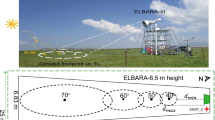Abstract
In China’s first lunar exploration project, Chang-E 1 (CE-1), a multi-channel microwave radiometer was aboard the satellite, with the purpose of measuring microwave brightness temperature from lunar surface and surveying the global distribution of lunar regolith layer thickness. In this paper, the primary 621 tracks of swath data measured by Chang-E 1 microwave radiometer from November 2007 to February 2008 are collected and analyzed. Using nearest neighbor interpolation based on the sun incidence angle in observations, global distributions of microwave brightness temperature from lunar surface at lunar daytime and nighttime are constructed. Using the three-layer model (the top dust-soil, regolith and underlying rock media) for microwave thermal emission of lunar surface, the measurements of brightness temperature and dependence upon latitude, frequency and FeO+TiO2 content, etc. are discussed. On the basis of the ground measurements at Apollo landing sites, the observed brightness temperature at these locations are validated and calibrated by numerical three-layer modeling. Using the empirical dependence of physical temperature upon the latitude verified by the measurements at Apollo landing sites, the global distribution of regolith layer thickness is then inverted from the brightness temperature data of CE-1 at 3 GHz channel. Those inversions at Apollo landing sites are compared with the Apollo in situ measurements. Finally, the statistical property of regolith thickness distribution is analyzed and discussed.
Similar content being viewed by others
References
McKay D, Heiken G, Basu A, et al. The lunar regolith. In: Heiken G H, Vaniman D T, French B M, eds. Lunar Source-Book: A User’s Guide to the Moon. New York: Cambridge University Press, 1991. 285–356
Shkuratov Y G, Bondarenko N V. Regolith layer thickness mapping of the Moon by radar and optical data. Icarus, 2001, 149: 329–338
Fa W, Jin Y Q. Simulation of brightness temperature from lunar surface and inversion of regolith layer thickness. J Geophys Res, 2007a, 112: E05003, doi: 10.1029/2006JE002751
Fa W, Jin Y Q. Quantitative estimation of helium-3 spatial distribution in the lunar regolith layer. Icarus, 2007b, 190: 15–23
Nakamura Y, Dorman J, Duennebier F, et al. Shallow lunar structure determined from the passive seismic experiment. Moon, 1975, 13: 3–15
Strangway D, Pearce G, Olhoeft G. Magnetic and dielectric properties of lunar samples, In: Vinogradov A P, ed. Kosmochimiya Luny i Planet (in Russian). Nauka, Moscow, 1975. 712–728
Quaide W L, Oberbeck V R. Thickness determinations of the lunar surface layer from lunar impact craters. J Geophys Res, 1968, 73: 5247–5270
Shoemaker E M, Baston R M, Holt H E, et al. Observations of the lunar regolith and the Earth from the television camera on Surveyor 7. J Geophys Res, 1969, 74: 6081–6119
Jiang J S. Microwave Moon (in Chinese). Sci China Ser D-Earth Sci, 2009, 39: 1028
Jin Y Q, Yan F, Liang Z. Simulation of brightness temperature from the Lunar surface using multi-channels microwave radiometers. Chinese J Radio Sci, 18: 477–486
Keihm S J, Gary B L. Comparison of theoretical and observed λ3.55 cm wavelength brightness temperature maps of the full moon. Proc Lunar Sci Conf, 1979, 10: 2311–2319
Lucey P G, Blewett D T, Jolliff B L. Lunar iron and titanium abundance algorithms based on final processing of Clementine ultraviolet-visible images. J Geophys Res, 2000, 105: 20297–20305
Zhang H, Zhang X, Yang J. The analysis of affections to the cold space calibration source of Chang-E 1 payload microwave detector. Adv Space Res, 2008, 42: 350–357
Heiken G H, Vaniman D T, French B M. Lunar Source-Book: A User’s Guide to the Moon. New York: Cambridge University Press, 1991
Shkuratov Y G, Kaydash V G, Bondarenko N V. Iron and titanium abundance and maturity degree distribution on the lunar nearside. Icarus, 1999, 137: 235–246
Hagfor T. Backscattering from an undulating surface with application to radar returns from the Moon. J Geophys Res, 1964, 97: 13319–13346
Lawrence D J, Feldman W C, Elphic R C, et al. Iron abundances on the lunar surface as measured by the Lunar prospector gamma-ray and neutron spectrometers. J Geophys Res, 2002, 107: 5130, doi: 10.1029/2001JE001530.
Shkuratov Y G, Kaydash V G, Stankevich D G, et al. Derivation of elemental abundance maps at intermediate resolution from optical interpolation of lunar prospector gamma-ray spectrometer data. Planetary Space Sci, 2005, 53: 1287–1301
Vasavada A R, Paige D A, Wood S E. Near-surface temperature on Mercury and the Moon and the stability of polar ice deposits. Icarus, 1999, 141: 179–193
Lawson S L, Jakosky B M, Park H S, et al. Brightness temperatures of the lunar surface: Calibration and global analysis of the Clementine long-wave infrared camera data. J Geophys Res, 2000, 105: 4273–4290
Author information
Authors and Affiliations
Corresponding author
Rights and permissions
About this article
Cite this article
Fa, W., Jin, Y. Analysis of microwave brightness temperature of lunar surface and inversion of regolith layer thickness: Primary results of Chang-E 1 multi-channel radiometer observation. Sci. China Ser. F-Inf. Sci. 53, 168–181 (2010). https://doi.org/10.1007/s11432-010-0020-1
Received:
Accepted:
Published:
Issue Date:
DOI: https://doi.org/10.1007/s11432-010-0020-1



